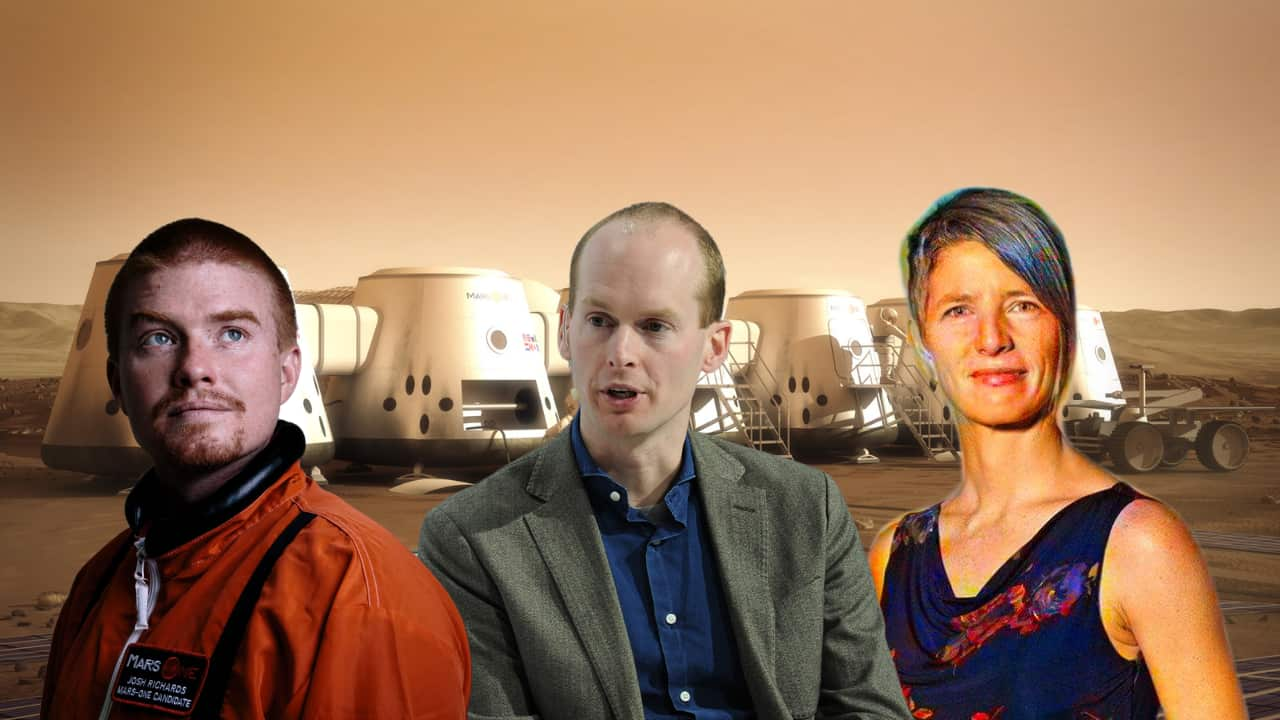The year is 2012. Think Gangnam Style, KONY, London Olympics and Julia Gillard standing up to Tony Abbott over misogyny. It was also the year an ambitious plan was announced to send humans to Mars: enter the Mars One project.
The man behind the estimated $6 billion USD plan was Dutch inventor and entrepreneur Bas Lansdorp. He'd previously worked for a wind energy company before launching the project, with a vision that was meant to see humans colonising and living — self-sustainably — on Mars for the rest of their lives. But they would also be human guinea pigs for surviving on the red planet. The media lapped it up.
The first of 100 applicants were supposed to have arrived on Mars by 2023. It's now 2025, and there are no human colonies on Mars. What happened?
'The Mars 100' vying for a chance to leave Earth
Applications for Mars One opened to the public in 2013. It involved a motivational letter, a resume and a video submission. Media attention quickly grew around the people who were willing to say goodbye to their loved ones and take the one-way trip.
Josh Richards was among seven Australian applicants who were selected for the final 100. His family were convinced he would leave and never return.
"I made my mum cry. The idea of her little boy leaving the planet … this was very real," Richards told The Feed.
"This was me making an active decision to leave the planet."

Richards delivered several talks relating to the Mars One project. Source: Supplied
An audience comparable to the Olympics
Mars One was not an aerospace company and never manufactured any technology for the mission. Lansdorp claimed everything the project needed was on the market already, from suppliers like SpaceX.
The one-way trip was intended to be funded in-part by a TV documentary series which followed the applicants throughout the recruitment process, preparation and settlement.
Lansdorp insisted it was not a reality TV show but said it would draw in crowd numbers and revenue comparable to the Olympics.
"The International Olympic Committee makes about four billion [US dollars] from sponsorships and broadcasting rights — so that's two-thirds of a Mars mission," Lansdorp told Engadget in a 2014 interview.

Mars One CEO Bas Lansdorp speaking to Engadget in 2014 as hype around the project grew. Source: Supplied / Bryan Bedder
The Feed tried to arrange an interview with Lansdorp.
But in 2019, after years of minimal news or announcements from Mars One, applicants received an email informing them that their dream was over: the project was bankrupt.
Richards said doubts started to grow when Mars One went quiet soon after announcing the 100 finalists.
"Personally, the longer it went on further past 2016, the more the doubts went; 'hey, maybe this particular project isn't going to happen. Maybe it's going to be a jumping off point for someone else," he said.
Maybe it's going to spur some other discussion or someone else picks this up.
Volunteering for death
A 2014 research report from the Massachusetts Institute of Technology titled "Mars One (and done?)" estimated humans would die within just 68 days of habitation, while others described it as a "suicide mission". Ulrich Walter told German newspaper Tagesspiegel in 2014 he estimated a 30 per cent chance of reaching Mars alive.
But having spent time in the military working with explosives, Richards said he had come to terms with the high risk of the project.
"That kind of acceptance of death was something that I'd come to terms with years before … comfortable with the idea that I was living; doing something that made a difference."
Another Australian finalist Dr Dianne McGrath had prepared for eight years, modifying her diet, meeting with psychologists and training with other applicants from the project.
"If we had the chance to rebuild or build Earth 2.0, so to speak, on another planet, could we get rid of some of the things on this planet that are not so great?" McGrath told The Feed.
"Could we restart again from a really positive learned experience, especially from the perspective of sustainability, but can we also look at the way that we govern ourselves? Can we look at the way that we welcome diversity?"

Dianne McGrath spent several years of her life preparing for a life on Mars. Source: Supplied
"I hung on to Mars One for a really long time. I suppose that hope that we would get news, that we would get updates, maybe stopped me doing things here on earth that I wanted to do," Richards said.
Andrew Dempster, director of the Australian Center for Space Engineering Research at UNSW said he doubted the application process.
"I'm not sure that they were really putting in the effort to make sure that the cohort of people they were taking were the right sort of people," he said.
"I think what was missing was the hard psychological testing. These people were volunteering to go to their deaths, with the only people they will know being others who have also made that choice."
The death of the Mars One dream
Cynicism had grown among applicants too, such as Joseph Roche, a previous NASA employee, who told Medium in 2015 he was concerned about the timeframe and the project's budget size.
Just a year earlier, he delivered a TEDx promoting the project.

A concept image from Mars One of how a human colony may look on the red planet.
Former Mars One ambassador and theoretical physicist Gerard't Hooft told The Guardian in 2015 that the project's budget and schedule were off by a factor of ten.
What's next for a mission to Mars?
While Elon Musk has suggested SpaceX could be sending humans to Mars by 2040, Dempster believes interest in the red planet has lessened in recent years.
"The balance of interest has moved away from Mars towards the Moon, partly because the Moon is proving more difficult than people may have expected," he said.

Elon Musk has said SpaceX have sights set for Mars by 2040. Source: Getty / Chandan Khanna
"I think the heat’s come out of Mars."
But Dempster said the bold project also launched conversation and academic interest around the feasibility of a trip to Mars.
"The fact that it [Mars One] existed as a proposal meant that people needed to make concrete criticisms of it, which were useful in developing the way forward."













